Bangladesh Factory Safety: Third-Party Conflict Resolution Analysis
VerifiedAdded on 2023/04/07
|7
|1702
|194
Report
AI Summary
This report examines the third-party conflict resolution strategies employed following the Rana Plaza factory collapse in Bangladesh, which involved international apparel companies, labor unions, and the Bangladesh government. The primary conflict stemmed from ensuring worker safety and maintaining business security in the international labor market. A formal intervention strategy was implemented, led by IndustriALL Global Union, to negotiate and establish the Bangladesh Factory Safety Agreement. Key players such as H&M, Inditex, and PVH Corp committed to improving factory safety standards, though approaches varied, with European brands generally taking more accountability than American retailers. The analysis reveals a utilitarian approach, aiming for the greatest benefit for the largest number by enhancing worker safety and preventing future crises. The report concludes that while the Accord and related initiatives have improved safety standards, greater aggregate support from American apparel giants would have strengthened the overall impact. Desklib provides access to similar reports and study resources for students.
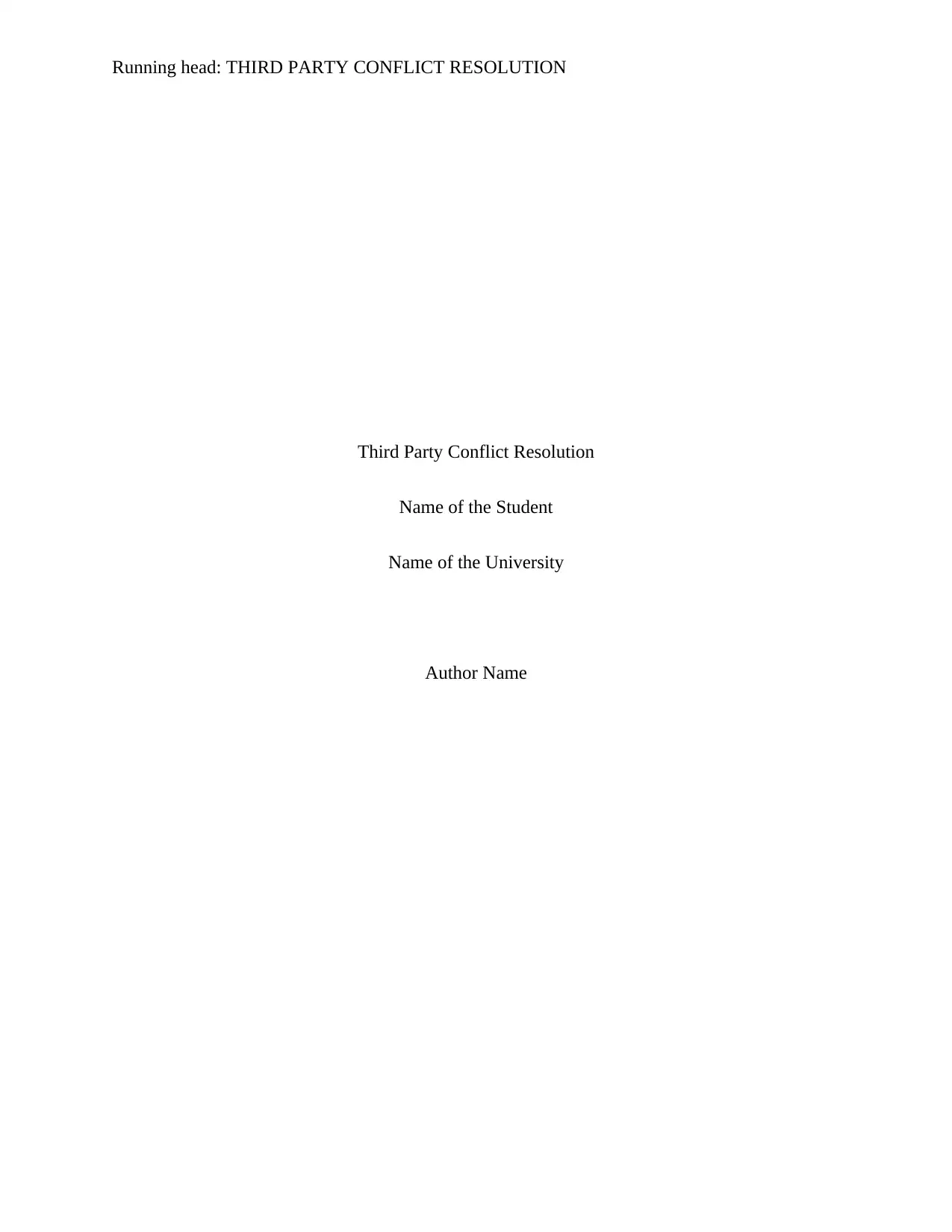
Running head: THIRD PARTY CONFLICT RESOLUTION
Third Party Conflict Resolution
Name of the Student
Name of the University
Author Name
Third Party Conflict Resolution
Name of the Student
Name of the University
Author Name
Paraphrase This Document
Need a fresh take? Get an instant paraphrase of this document with our AI Paraphraser
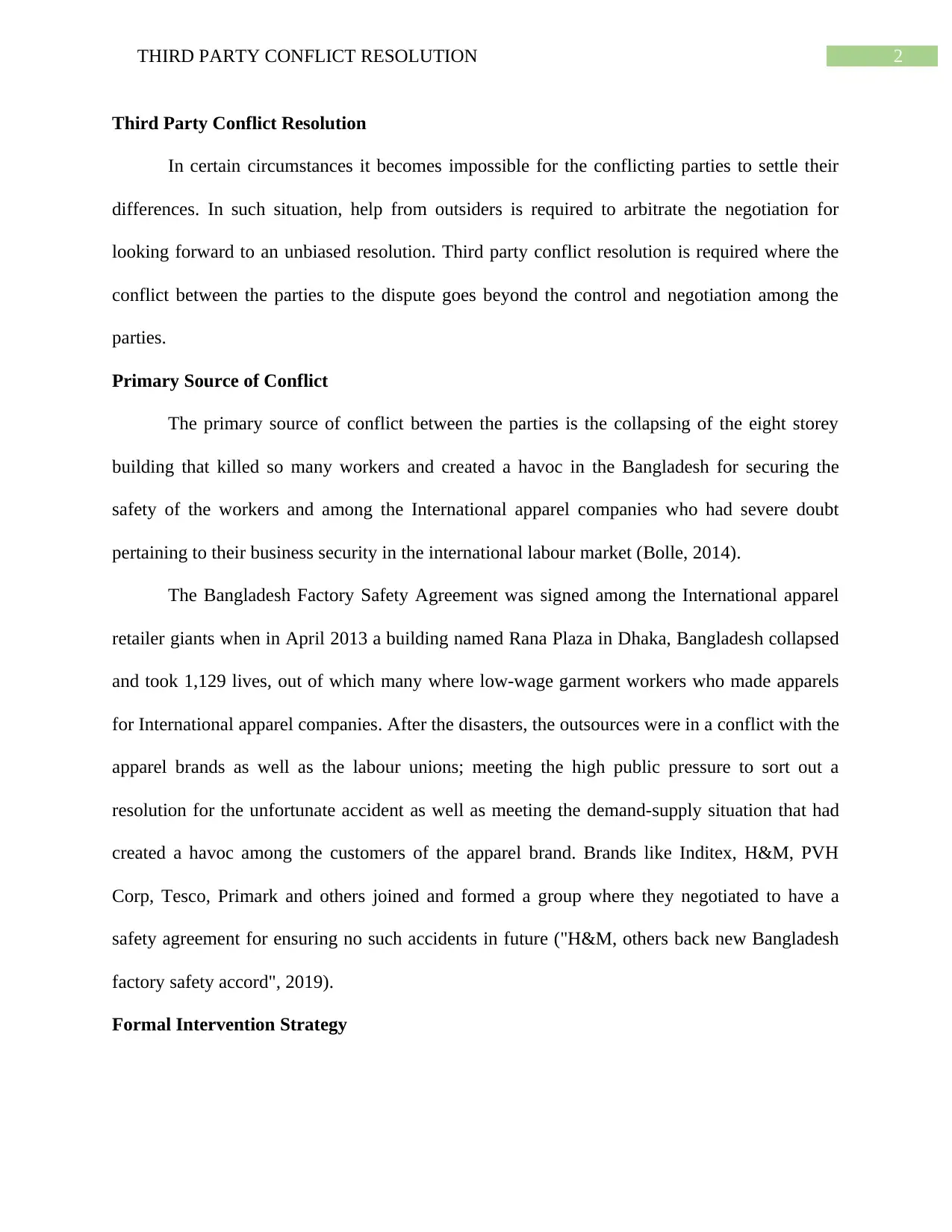
2THIRD PARTY CONFLICT RESOLUTION
Third Party Conflict Resolution
In certain circumstances it becomes impossible for the conflicting parties to settle their
differences. In such situation, help from outsiders is required to arbitrate the negotiation for
looking forward to an unbiased resolution. Third party conflict resolution is required where the
conflict between the parties to the dispute goes beyond the control and negotiation among the
parties.
Primary Source of Conflict
The primary source of conflict between the parties is the collapsing of the eight storey
building that killed so many workers and created a havoc in the Bangladesh for securing the
safety of the workers and among the International apparel companies who had severe doubt
pertaining to their business security in the international labour market (Bolle, 2014).
The Bangladesh Factory Safety Agreement was signed among the International apparel
retailer giants when in April 2013 a building named Rana Plaza in Dhaka, Bangladesh collapsed
and took 1,129 lives, out of which many where low-wage garment workers who made apparels
for International apparel companies. After the disasters, the outsources were in a conflict with the
apparel brands as well as the labour unions; meeting the high public pressure to sort out a
resolution for the unfortunate accident as well as meeting the demand-supply situation that had
created a havoc among the customers of the apparel brand. Brands like Inditex, H&M, PVH
Corp, Tesco, Primark and others joined and formed a group where they negotiated to have a
safety agreement for ensuring no such accidents in future ("H&M, others back new Bangladesh
factory safety accord", 2019).
Formal Intervention Strategy
Third Party Conflict Resolution
In certain circumstances it becomes impossible for the conflicting parties to settle their
differences. In such situation, help from outsiders is required to arbitrate the negotiation for
looking forward to an unbiased resolution. Third party conflict resolution is required where the
conflict between the parties to the dispute goes beyond the control and negotiation among the
parties.
Primary Source of Conflict
The primary source of conflict between the parties is the collapsing of the eight storey
building that killed so many workers and created a havoc in the Bangladesh for securing the
safety of the workers and among the International apparel companies who had severe doubt
pertaining to their business security in the international labour market (Bolle, 2014).
The Bangladesh Factory Safety Agreement was signed among the International apparel
retailer giants when in April 2013 a building named Rana Plaza in Dhaka, Bangladesh collapsed
and took 1,129 lives, out of which many where low-wage garment workers who made apparels
for International apparel companies. After the disasters, the outsources were in a conflict with the
apparel brands as well as the labour unions; meeting the high public pressure to sort out a
resolution for the unfortunate accident as well as meeting the demand-supply situation that had
created a havoc among the customers of the apparel brand. Brands like Inditex, H&M, PVH
Corp, Tesco, Primark and others joined and formed a group where they negotiated to have a
safety agreement for ensuring no such accidents in future ("H&M, others back new Bangladesh
factory safety accord", 2019).
Formal Intervention Strategy
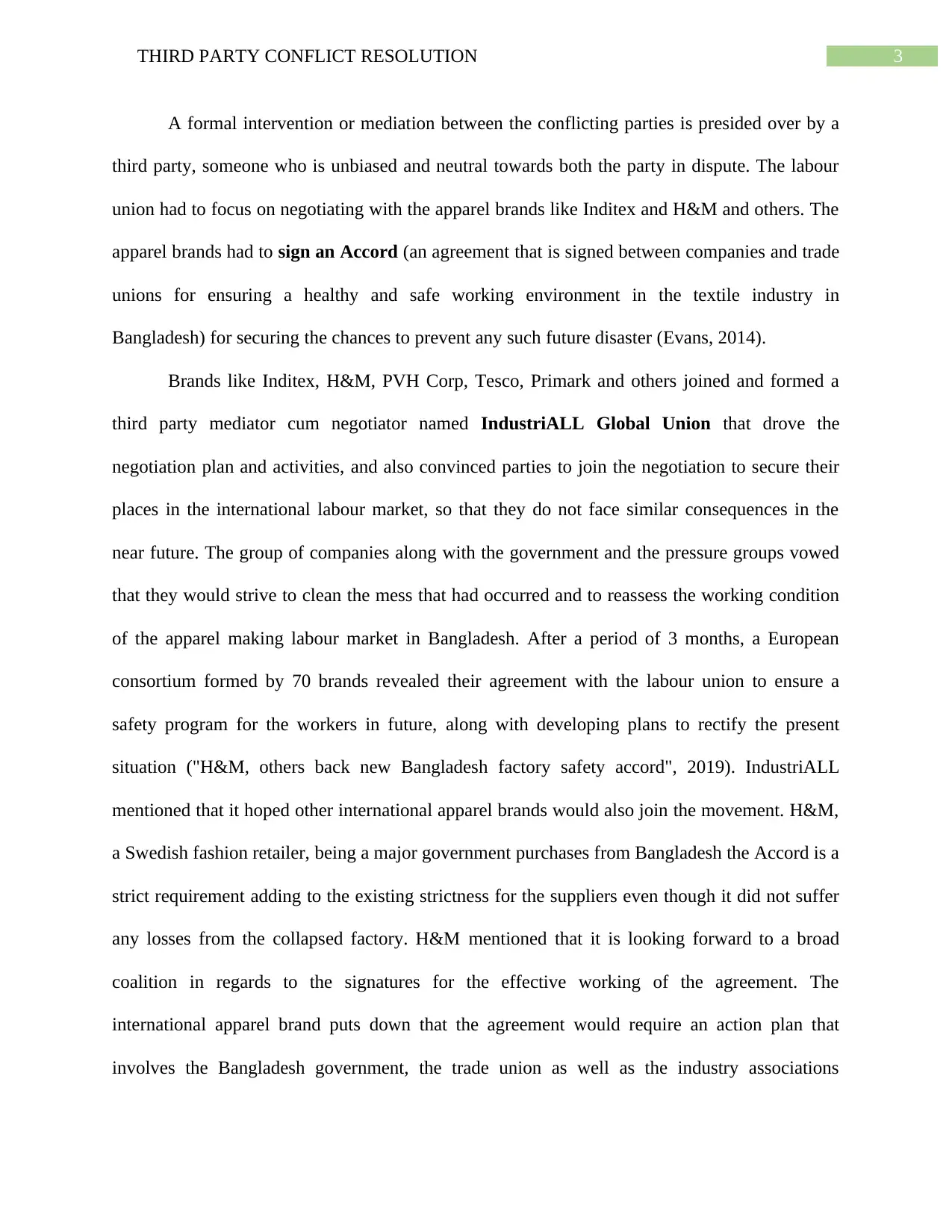
3THIRD PARTY CONFLICT RESOLUTION
A formal intervention or mediation between the conflicting parties is presided over by a
third party, someone who is unbiased and neutral towards both the party in dispute. The labour
union had to focus on negotiating with the apparel brands like Inditex and H&M and others. The
apparel brands had to sign an Accord (an agreement that is signed between companies and trade
unions for ensuring a healthy and safe working environment in the textile industry in
Bangladesh) for securing the chances to prevent any such future disaster (Evans, 2014).
Brands like Inditex, H&M, PVH Corp, Tesco, Primark and others joined and formed a
third party mediator cum negotiator named IndustriALL Global Union that drove the
negotiation plan and activities, and also convinced parties to join the negotiation to secure their
places in the international labour market, so that they do not face similar consequences in the
near future. The group of companies along with the government and the pressure groups vowed
that they would strive to clean the mess that had occurred and to reassess the working condition
of the apparel making labour market in Bangladesh. After a period of 3 months, a European
consortium formed by 70 brands revealed their agreement with the labour union to ensure a
safety program for the workers in future, along with developing plans to rectify the present
situation ("H&M, others back new Bangladesh factory safety accord", 2019). IndustriALL
mentioned that it hoped other international apparel brands would also join the movement. H&M,
a Swedish fashion retailer, being a major government purchases from Bangladesh the Accord is a
strict requirement adding to the existing strictness for the suppliers even though it did not suffer
any losses from the collapsed factory. H&M mentioned that it is looking forward to a broad
coalition in regards to the signatures for the effective working of the agreement. The
international apparel brand puts down that the agreement would require an action plan that
involves the Bangladesh government, the trade union as well as the industry associations
A formal intervention or mediation between the conflicting parties is presided over by a
third party, someone who is unbiased and neutral towards both the party in dispute. The labour
union had to focus on negotiating with the apparel brands like Inditex and H&M and others. The
apparel brands had to sign an Accord (an agreement that is signed between companies and trade
unions for ensuring a healthy and safe working environment in the textile industry in
Bangladesh) for securing the chances to prevent any such future disaster (Evans, 2014).
Brands like Inditex, H&M, PVH Corp, Tesco, Primark and others joined and formed a
third party mediator cum negotiator named IndustriALL Global Union that drove the
negotiation plan and activities, and also convinced parties to join the negotiation to secure their
places in the international labour market, so that they do not face similar consequences in the
near future. The group of companies along with the government and the pressure groups vowed
that they would strive to clean the mess that had occurred and to reassess the working condition
of the apparel making labour market in Bangladesh. After a period of 3 months, a European
consortium formed by 70 brands revealed their agreement with the labour union to ensure a
safety program for the workers in future, along with developing plans to rectify the present
situation ("H&M, others back new Bangladesh factory safety accord", 2019). IndustriALL
mentioned that it hoped other international apparel brands would also join the movement. H&M,
a Swedish fashion retailer, being a major government purchases from Bangladesh the Accord is a
strict requirement adding to the existing strictness for the suppliers even though it did not suffer
any losses from the collapsed factory. H&M mentioned that it is looking forward to a broad
coalition in regards to the signatures for the effective working of the agreement. The
international apparel brand puts down that the agreement would require an action plan that
involves the Bangladesh government, the trade union as well as the industry associations
⊘ This is a preview!⊘
Do you want full access?
Subscribe today to unlock all pages.

Trusted by 1+ million students worldwide
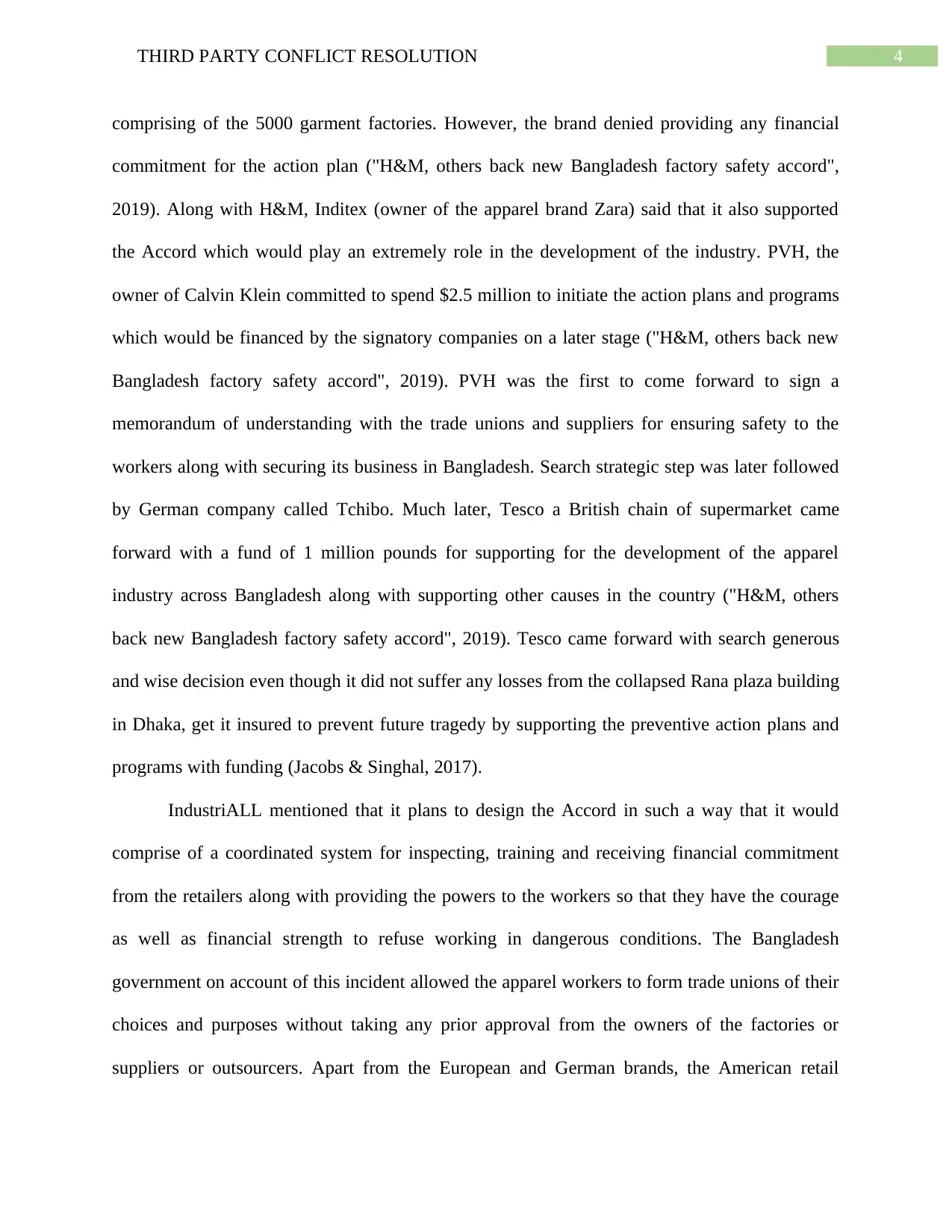
4THIRD PARTY CONFLICT RESOLUTION
comprising of the 5000 garment factories. However, the brand denied providing any financial
commitment for the action plan ("H&M, others back new Bangladesh factory safety accord",
2019). Along with H&M, Inditex (owner of the apparel brand Zara) said that it also supported
the Accord which would play an extremely role in the development of the industry. PVH, the
owner of Calvin Klein committed to spend $2.5 million to initiate the action plans and programs
which would be financed by the signatory companies on a later stage ("H&M, others back new
Bangladesh factory safety accord", 2019). PVH was the first to come forward to sign a
memorandum of understanding with the trade unions and suppliers for ensuring safety to the
workers along with securing its business in Bangladesh. Search strategic step was later followed
by German company called Tchibo. Much later, Tesco a British chain of supermarket came
forward with a fund of 1 million pounds for supporting for the development of the apparel
industry across Bangladesh along with supporting other causes in the country ("H&M, others
back new Bangladesh factory safety accord", 2019). Tesco came forward with search generous
and wise decision even though it did not suffer any losses from the collapsed Rana plaza building
in Dhaka, get it insured to prevent future tragedy by supporting the preventive action plans and
programs with funding (Jacobs & Singhal, 2017).
IndustriALL mentioned that it plans to design the Accord in such a way that it would
comprise of a coordinated system for inspecting, training and receiving financial commitment
from the retailers along with providing the powers to the workers so that they have the courage
as well as financial strength to refuse working in dangerous conditions. The Bangladesh
government on account of this incident allowed the apparel workers to form trade unions of their
choices and purposes without taking any prior approval from the owners of the factories or
suppliers or outsourcers. Apart from the European and German brands, the American retail
comprising of the 5000 garment factories. However, the brand denied providing any financial
commitment for the action plan ("H&M, others back new Bangladesh factory safety accord",
2019). Along with H&M, Inditex (owner of the apparel brand Zara) said that it also supported
the Accord which would play an extremely role in the development of the industry. PVH, the
owner of Calvin Klein committed to spend $2.5 million to initiate the action plans and programs
which would be financed by the signatory companies on a later stage ("H&M, others back new
Bangladesh factory safety accord", 2019). PVH was the first to come forward to sign a
memorandum of understanding with the trade unions and suppliers for ensuring safety to the
workers along with securing its business in Bangladesh. Search strategic step was later followed
by German company called Tchibo. Much later, Tesco a British chain of supermarket came
forward with a fund of 1 million pounds for supporting for the development of the apparel
industry across Bangladesh along with supporting other causes in the country ("H&M, others
back new Bangladesh factory safety accord", 2019). Tesco came forward with search generous
and wise decision even though it did not suffer any losses from the collapsed Rana plaza building
in Dhaka, get it insured to prevent future tragedy by supporting the preventive action plans and
programs with funding (Jacobs & Singhal, 2017).
IndustriALL mentioned that it plans to design the Accord in such a way that it would
comprise of a coordinated system for inspecting, training and receiving financial commitment
from the retailers along with providing the powers to the workers so that they have the courage
as well as financial strength to refuse working in dangerous conditions. The Bangladesh
government on account of this incident allowed the apparel workers to form trade unions of their
choices and purposes without taking any prior approval from the owners of the factories or
suppliers or outsourcers. Apart from the European and German brands, the American retail
Paraphrase This Document
Need a fresh take? Get an instant paraphrase of this document with our AI Paraphraser
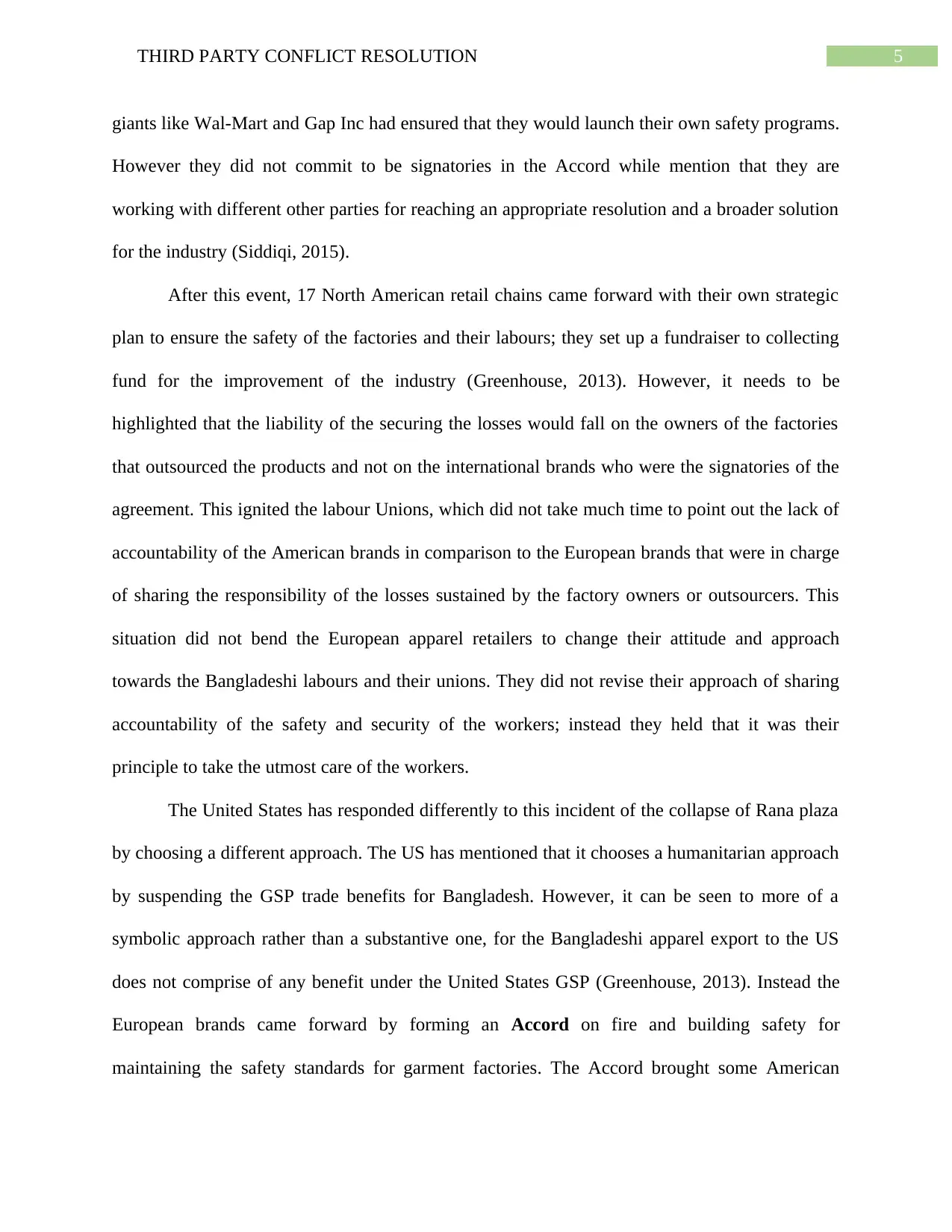
5THIRD PARTY CONFLICT RESOLUTION
giants like Wal-Mart and Gap Inc had ensured that they would launch their own safety programs.
However they did not commit to be signatories in the Accord while mention that they are
working with different other parties for reaching an appropriate resolution and a broader solution
for the industry (Siddiqi, 2015).
After this event, 17 North American retail chains came forward with their own strategic
plan to ensure the safety of the factories and their labours; they set up a fundraiser to collecting
fund for the improvement of the industry (Greenhouse, 2013). However, it needs to be
highlighted that the liability of the securing the losses would fall on the owners of the factories
that outsourced the products and not on the international brands who were the signatories of the
agreement. This ignited the labour Unions, which did not take much time to point out the lack of
accountability of the American brands in comparison to the European brands that were in charge
of sharing the responsibility of the losses sustained by the factory owners or outsourcers. This
situation did not bend the European apparel retailers to change their attitude and approach
towards the Bangladeshi labours and their unions. They did not revise their approach of sharing
accountability of the safety and security of the workers; instead they held that it was their
principle to take the utmost care of the workers.
The United States has responded differently to this incident of the collapse of Rana plaza
by choosing a different approach. The US has mentioned that it chooses a humanitarian approach
by suspending the GSP trade benefits for Bangladesh. However, it can be seen to more of a
symbolic approach rather than a substantive one, for the Bangladeshi apparel export to the US
does not comprise of any benefit under the United States GSP (Greenhouse, 2013). Instead the
European brands came forward by forming an Accord on fire and building safety for
maintaining the safety standards for garment factories. The Accord brought some American
giants like Wal-Mart and Gap Inc had ensured that they would launch their own safety programs.
However they did not commit to be signatories in the Accord while mention that they are
working with different other parties for reaching an appropriate resolution and a broader solution
for the industry (Siddiqi, 2015).
After this event, 17 North American retail chains came forward with their own strategic
plan to ensure the safety of the factories and their labours; they set up a fundraiser to collecting
fund for the improvement of the industry (Greenhouse, 2013). However, it needs to be
highlighted that the liability of the securing the losses would fall on the owners of the factories
that outsourced the products and not on the international brands who were the signatories of the
agreement. This ignited the labour Unions, which did not take much time to point out the lack of
accountability of the American brands in comparison to the European brands that were in charge
of sharing the responsibility of the losses sustained by the factory owners or outsourcers. This
situation did not bend the European apparel retailers to change their attitude and approach
towards the Bangladeshi labours and their unions. They did not revise their approach of sharing
accountability of the safety and security of the workers; instead they held that it was their
principle to take the utmost care of the workers.
The United States has responded differently to this incident of the collapse of Rana plaza
by choosing a different approach. The US has mentioned that it chooses a humanitarian approach
by suspending the GSP trade benefits for Bangladesh. However, it can be seen to more of a
symbolic approach rather than a substantive one, for the Bangladeshi apparel export to the US
does not comprise of any benefit under the United States GSP (Greenhouse, 2013). Instead the
European brands came forward by forming an Accord on fire and building safety for
maintaining the safety standards for garment factories. The Accord brought some American
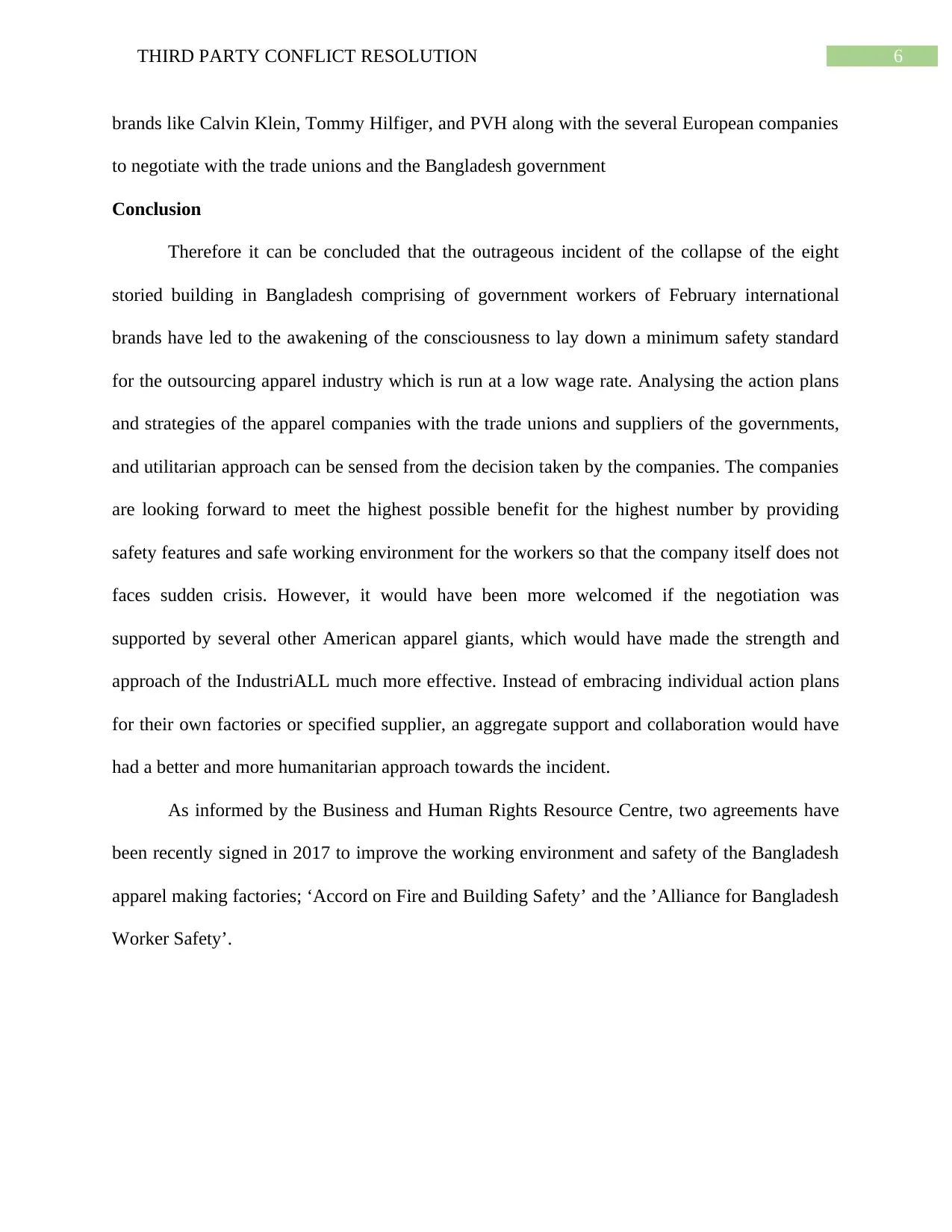
6THIRD PARTY CONFLICT RESOLUTION
brands like Calvin Klein, Tommy Hilfiger, and PVH along with the several European companies
to negotiate with the trade unions and the Bangladesh government
Conclusion
Therefore it can be concluded that the outrageous incident of the collapse of the eight
storied building in Bangladesh comprising of government workers of February international
brands have led to the awakening of the consciousness to lay down a minimum safety standard
for the outsourcing apparel industry which is run at a low wage rate. Analysing the action plans
and strategies of the apparel companies with the trade unions and suppliers of the governments,
and utilitarian approach can be sensed from the decision taken by the companies. The companies
are looking forward to meet the highest possible benefit for the highest number by providing
safety features and safe working environment for the workers so that the company itself does not
faces sudden crisis. However, it would have been more welcomed if the negotiation was
supported by several other American apparel giants, which would have made the strength and
approach of the IndustriALL much more effective. Instead of embracing individual action plans
for their own factories or specified supplier, an aggregate support and collaboration would have
had a better and more humanitarian approach towards the incident.
As informed by the Business and Human Rights Resource Centre, two agreements have
been recently signed in 2017 to improve the working environment and safety of the Bangladesh
apparel making factories; ‘Accord on Fire and Building Safety’ and the ’Alliance for Bangladesh
Worker Safety’.
brands like Calvin Klein, Tommy Hilfiger, and PVH along with the several European companies
to negotiate with the trade unions and the Bangladesh government
Conclusion
Therefore it can be concluded that the outrageous incident of the collapse of the eight
storied building in Bangladesh comprising of government workers of February international
brands have led to the awakening of the consciousness to lay down a minimum safety standard
for the outsourcing apparel industry which is run at a low wage rate. Analysing the action plans
and strategies of the apparel companies with the trade unions and suppliers of the governments,
and utilitarian approach can be sensed from the decision taken by the companies. The companies
are looking forward to meet the highest possible benefit for the highest number by providing
safety features and safe working environment for the workers so that the company itself does not
faces sudden crisis. However, it would have been more welcomed if the negotiation was
supported by several other American apparel giants, which would have made the strength and
approach of the IndustriALL much more effective. Instead of embracing individual action plans
for their own factories or specified supplier, an aggregate support and collaboration would have
had a better and more humanitarian approach towards the incident.
As informed by the Business and Human Rights Resource Centre, two agreements have
been recently signed in 2017 to improve the working environment and safety of the Bangladesh
apparel making factories; ‘Accord on Fire and Building Safety’ and the ’Alliance for Bangladesh
Worker Safety’.
⊘ This is a preview!⊘
Do you want full access?
Subscribe today to unlock all pages.

Trusted by 1+ million students worldwide
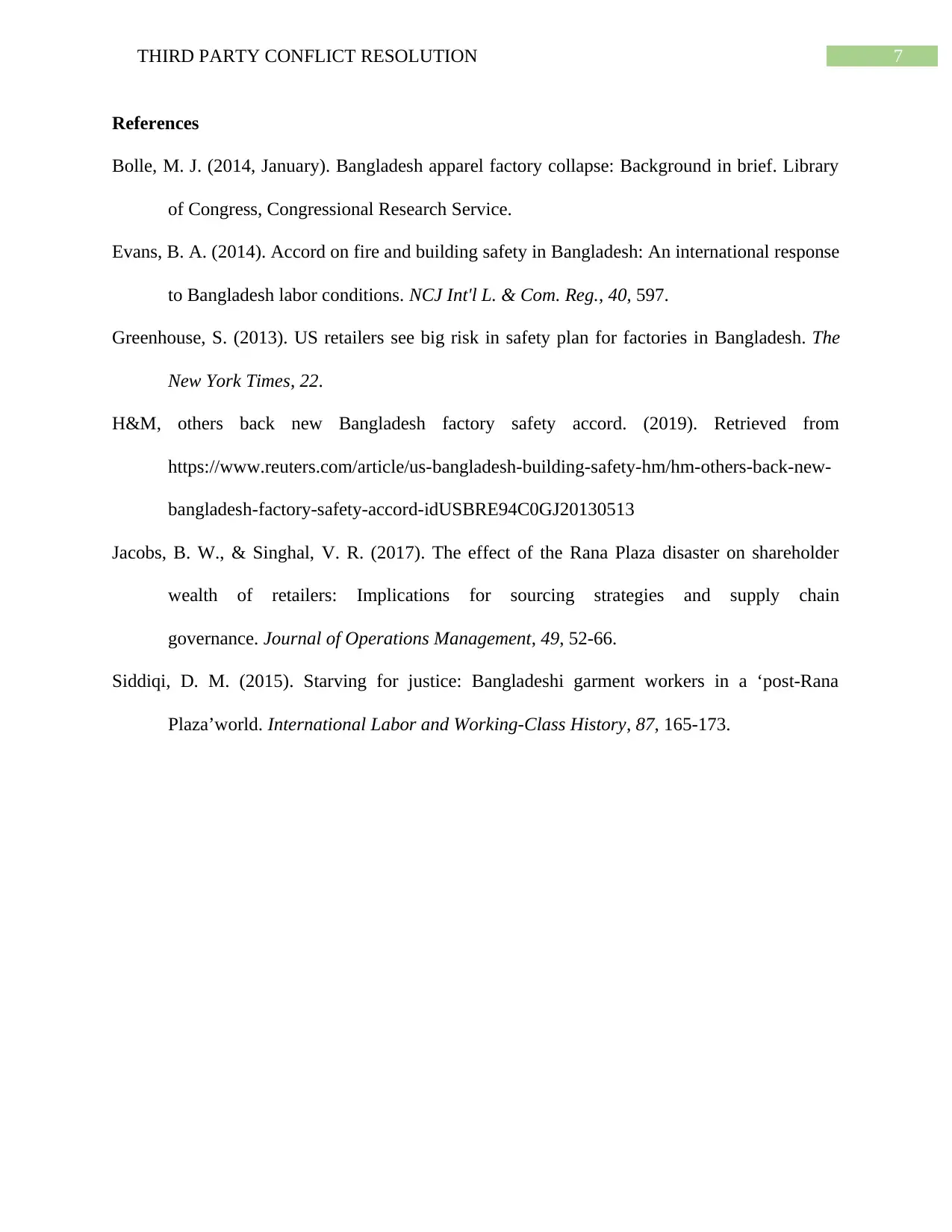
7THIRD PARTY CONFLICT RESOLUTION
References
Bolle, M. J. (2014, January). Bangladesh apparel factory collapse: Background in brief. Library
of Congress, Congressional Research Service.
Evans, B. A. (2014). Accord on fire and building safety in Bangladesh: An international response
to Bangladesh labor conditions. NCJ Int'l L. & Com. Reg., 40, 597.
Greenhouse, S. (2013). US retailers see big risk in safety plan for factories in Bangladesh. The
New York Times, 22.
H&M, others back new Bangladesh factory safety accord. (2019). Retrieved from
https://www.reuters.com/article/us-bangladesh-building-safety-hm/hm-others-back-new-
bangladesh-factory-safety-accord-idUSBRE94C0GJ20130513
Jacobs, B. W., & Singhal, V. R. (2017). The effect of the Rana Plaza disaster on shareholder
wealth of retailers: Implications for sourcing strategies and supply chain
governance. Journal of Operations Management, 49, 52-66.
Siddiqi, D. M. (2015). Starving for justice: Bangladeshi garment workers in a ‘post-Rana
Plaza’world. International Labor and Working-Class History, 87, 165-173.
References
Bolle, M. J. (2014, January). Bangladesh apparel factory collapse: Background in brief. Library
of Congress, Congressional Research Service.
Evans, B. A. (2014). Accord on fire and building safety in Bangladesh: An international response
to Bangladesh labor conditions. NCJ Int'l L. & Com. Reg., 40, 597.
Greenhouse, S. (2013). US retailers see big risk in safety plan for factories in Bangladesh. The
New York Times, 22.
H&M, others back new Bangladesh factory safety accord. (2019). Retrieved from
https://www.reuters.com/article/us-bangladesh-building-safety-hm/hm-others-back-new-
bangladesh-factory-safety-accord-idUSBRE94C0GJ20130513
Jacobs, B. W., & Singhal, V. R. (2017). The effect of the Rana Plaza disaster on shareholder
wealth of retailers: Implications for sourcing strategies and supply chain
governance. Journal of Operations Management, 49, 52-66.
Siddiqi, D. M. (2015). Starving for justice: Bangladeshi garment workers in a ‘post-Rana
Plaza’world. International Labor and Working-Class History, 87, 165-173.
1 out of 7
Your All-in-One AI-Powered Toolkit for Academic Success.
+13062052269
info@desklib.com
Available 24*7 on WhatsApp / Email
![[object Object]](/_next/static/media/star-bottom.7253800d.svg)
Unlock your academic potential
Copyright © 2020–2025 A2Z Services. All Rights Reserved. Developed and managed by ZUCOL.